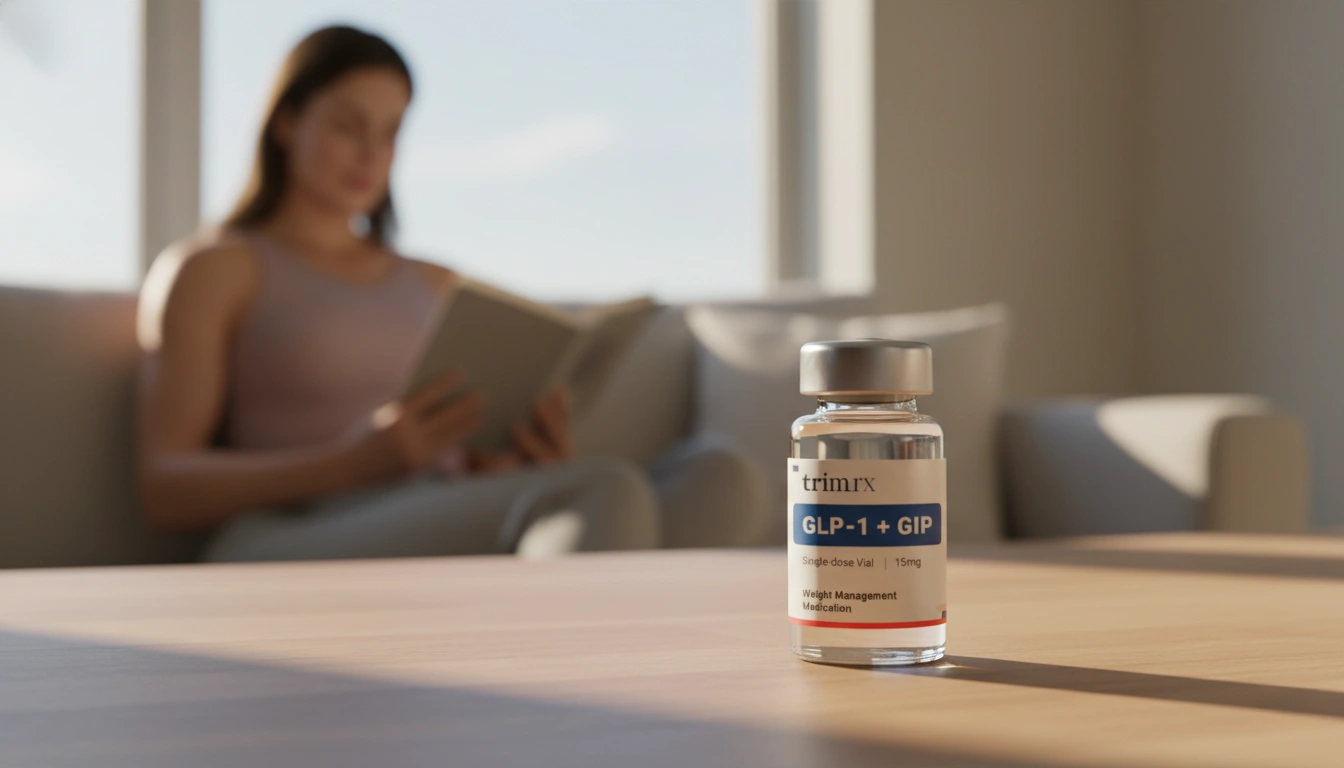Does GLP-1 Cause Headaches? Understanding the Connection

Headaches are an all-too-familiar ailment for many individuals, and when starting a new medication, the question often arises: could this be contributing to my discomfort? With the growing popularity of GLP-1 receptor agonists in managing conditions such as type 2 diabetes and obesity, it’s crucial to explore their potential side effects, particularly headaches.
At TrimRx, we believe in providing transparent, evidence-based information to help you make informed decisions about your health. In this comprehensive blog post, we will delve into the relationship between GLP-1 medications and headaches, discussing how these drugs work, the possible side effects, and what you can do if you experience headaches while on these treatments. By the end, you’ll have a clearer understanding of whether GLP-1 drugs might be impacting your head health and how to navigate any challenges that arise.
Introduction
Did you know that nearly half of all adults experience headaches at some point in their lives? This common ailment can range from mild tension headaches to debilitating migraines. As more people turn to GLP-1 receptor agonists for weight management and diabetes control, questions are surfacing about whether these medications could be responsible for triggering headaches.
GLP-1 (glucagon-like peptide-1) receptor agonists have gained traction over recent years due to their effectiveness in lowering blood sugar levels and promoting weight loss. While they offer numerous benefits, they are not without their potential side effects. In particular, reports of headaches among users have sparked our interest in understanding this connection better.
In this blog, we will cover the following key topics:
- What GLP-1 medications are and how they work
- The common side effects of GLP-1 drugs, including headaches
- The potential mechanisms linking GLP-1 medications to headaches
- Management strategies for those experiencing headaches while on GLP-1 therapy
- Insights into ongoing research examining the relationship between GLP-1 drugs and headache disorders
As we navigate this topic together, we encourage you to reflect on your experiences and consider how this information may relate to your health journey. Let’s uncover the complexities of GLP-1 medications and their potential impact on headache symptoms.
What Are GLP-1 Medications?
GLP-1 medications belong to a class of drugs known as GLP-1 receptor agonists. These medications are primarily prescribed to manage type 2 diabetes and promote weight loss, making them a dual-purpose treatment.
Mechanism of Action
GLP-1 is a hormone that your intestines produce, which plays a vital role in regulating blood sugar levels. When you eat, GLP-1 is released and stimulates insulin secretion from the pancreas while inhibiting glucagon release, which helps lower blood sugar. Additionally, GLP-1 slows gastric emptying, leading to increased feelings of fullness after meals.
Here are some commonly prescribed GLP-1 medications:
- Semaglutide (Ozempic®, Wegovy®)
- Liraglutide (Saxenda®)
- Dulaglutide (Trulicity)
- Exenatide (Byetta, Bydureon)
As these medications mimic the effects of natural GLP-1, they can significantly aid individuals in managing their blood sugar levels and achieving weight loss.
Common Side Effects of GLP-1 Medications
While GLP-1 medications are effective, they can come with a range of side effects. Understanding these can help you prepare for what to expect when starting treatment.
Gastrointestinal Symptoms
The most frequently reported side effects of GLP-1 receptor agonists are gastrointestinal in nature. These may include:
- Nausea
- Vomiting
- Diarrhea
- Constipation
These symptoms are often temporary and may improve over time as your body adjusts to the medication. However, they can lead to discomfort and may exacerbate other issues, such as headaches.
Headaches
Among the various side effects, headaches have been reported, although they are not typically listed as a primary side effect. Some studies indicate that a small percentage of users experience headache symptoms, particularly when adjusting to higher doses of medication.
Other Potential Side Effects
Other side effects of GLP-1 medications can include:
- Dizziness
- Fatigue
- Injection site reactions (such as redness or swelling)
- Hypoglycemia (low blood sugar)
It’s essential to be aware of these possible effects to recognize and address any concerns proactively.
The Connection Between GLP-1 Medications and Headaches
Understanding whether GLP-1 medications can cause headaches involves exploring possible mechanisms and individual responses to the drugs.
Individual Variation
Reactions to GLP-1 medications can vary significantly from person to person. While some may experience only mild headaches, others—especially those prone to migraines—might find their symptoms exacerbated. The reasons for this variability are not entirely clear, but several factors may contribute.
Blood Sugar Fluctuations
One potential connection between GLP-1 medications and headaches lies in their effect on blood sugar levels. Hypoglycemia (low blood sugar) is a known migraine trigger and can occur if blood sugar levels drop too low. Since GLP-1 medications influence insulin secretion and gastric emptying, fluctuations in blood sugar may lead to headache symptoms for some individuals.
Dehydration and Nutrient Absorption
GLP-1 medications slow gastric emptying, which can impact hydration and nutrient absorption. Dehydration is another common headache trigger, and if you experience nausea or vomiting as a side effect, you may be at an increased risk of dehydration, potentially leading to headaches.
Neuroinflammation
Emerging research suggests that GLP-1 drugs may influence neuroinflammation, a known factor in the development of headaches and migraines. Studies in animal models indicate that GLP-1 receptor agonists can reduce pain signaling and lower neuroinflammation, which could have implications for migraine management in some cases. However, further research is necessary to understand fully how these mechanisms may play out in human subjects.
Research Perspectives
While some studies have reported headaches among individuals taking GLP-1 medications, the overall findings are mixed. For example, one clinical trial noted that 15.2% of participants on higher-dose semaglutide experienced headaches, compared to 12.2% of those receiving a placebo. This suggests that while there may be a connection, it is not definitive, and other factors may be at play.
Managing Headaches While on GLP-1 Medications
If you are experiencing headaches while taking GLP-1 medications, there are several strategies you can implement to help manage your symptoms effectively.
Consult Your Healthcare Provider
The first step in addressing any persistent headaches is to communicate with your healthcare provider. They can evaluate your symptoms and may suggest adjusting your dosage or switching to a different GLP-1 medication that might have fewer side effects.
Monitor Blood Sugar Levels
If you are using GLP-1 medications to manage diabetes, it’s crucial to monitor your blood sugar levels closely. Keeping your blood sugar stable can help prevent headache-triggering hypoglycemia. Work with your healthcare team to establish a plan for regular monitoring and management.
Stay Hydrated
Dehydration is a common headache trigger, so it’s vital to drink plenty of water throughout the day. If you experience nausea or vomiting as a side effect of your medication, this could further compound the risk of dehydration. Aim to stay well-hydrated, especially when starting a new medication.
Identify Triggers
Keeping a headache diary can help you identify potential triggers, including food, stress, or other lifestyle factors. Recognizing patterns can empower you to make adjustments and reduce the frequency of headaches.
Explore Alternative Treatments
If headaches persist despite your best efforts, discuss the possibility of exploring alternative medications with your healthcare provider. Other classes of diabetes medications or weight loss drugs may have side effects that are more manageable for you.
Emerging Research: GLP-1 Drugs and Headache Disorders
Interestingly, while GLP-1 medications may lead to headaches in some individuals, recent studies are exploring their potential benefits for specific headache disorders.
Idiopathic Intracranial Hypertension (IIH)
Recent research has investigated the role of GLP-1 drugs in managing idiopathic intracranial hypertension (IIH), a condition characterized by increased pressure inside the skull that can lead to severe headaches. Since weight loss is a primary treatment for IIH, GLP-1 drugs are being studied as possible therapeutic options.
Migraine Management Potential
Some animal studies have suggested that GLP-1 receptor agonists could help reduce migraine-related pain through their effects on neuroinflammation and pain signaling. However, human clinical trials are necessary to validate these findings and determine the applicability of GLP-1 drugs in migraine management.
Conclusion
Navigating the world of GLP-1 medications can be complex, especially when considering side effects like headaches. While some individuals may experience headaches while taking these medications, the connection is not fully understood and can vary widely among users.
At TrimRx, we prioritize providing personalized, medically supervised weight loss solutions that consider each individual’s unique health journey. If you’re exploring GLP-1 medications for weight management or diabetes, it’s essential to stay informed about potential side effects and to communicate openly with your healthcare provider.
As ongoing research continues to unveil new insights into the relationship between GLP-1 drugs and headaches, we encourage you to reflect on your experiences and seek guidance to optimize your treatment plan. If you’re interested in personalized weight loss solutions, we invite you to take our free assessment quiz to see if you qualify for our prescription weight loss medications, designed to support your journey towards a healthier lifestyle.
FAQ
Can GLP-1 medications cause headaches?
Yes, some users have reported headaches while taking GLP-1 medications, although they are not typically listed as a primary side effect. Variability in individual responses can lead to different experiences.
What should I do if I experience headaches while taking GLP-1 drugs?
Consult with your healthcare provider to discuss your symptoms. They may adjust your dosage or suggest alternative medications that may be more suitable for you.
Are headaches a common side effect of GLP-1 medications?
Headaches are not the most common side effect associated with GLP-1 medications, which primarily include gastrointestinal symptoms. However, some individuals may experience headaches.
How can I manage headaches while on GLP-1 therapy?
Strategies include monitoring blood sugar levels, staying hydrated, identifying headache triggers, and consulting with your healthcare provider about adjustments to your medication.
Is there any ongoing research about GLP-1 medications and headaches?
Yes, emerging research is exploring the potential benefits of GLP-1 drugs in treating specific headache disorders, such as idiopathic intracranial hypertension, and their overall impact on migraine management.

Transforming Lives, One Step at a Time
Keep reading
Vitamin B12 and GLP-1 Medications: What to Know
GLP-1 medications can lower B12 absorption and intake; learn symptoms, food sources, supplement options, and how to monitor levels.
Semaglutide Injection Site Reactions: What To Know
Learn why semaglutide injections can cause redness, swelling or nodules, how to prevent and treat them, and when to seek medical care.
TrimRx vs Friday’s
Compare TrimRx and Friday’s telehealth GLP-1 weight-loss programs: pricing, medical support, coaching, delivery, and which fits your needs.



